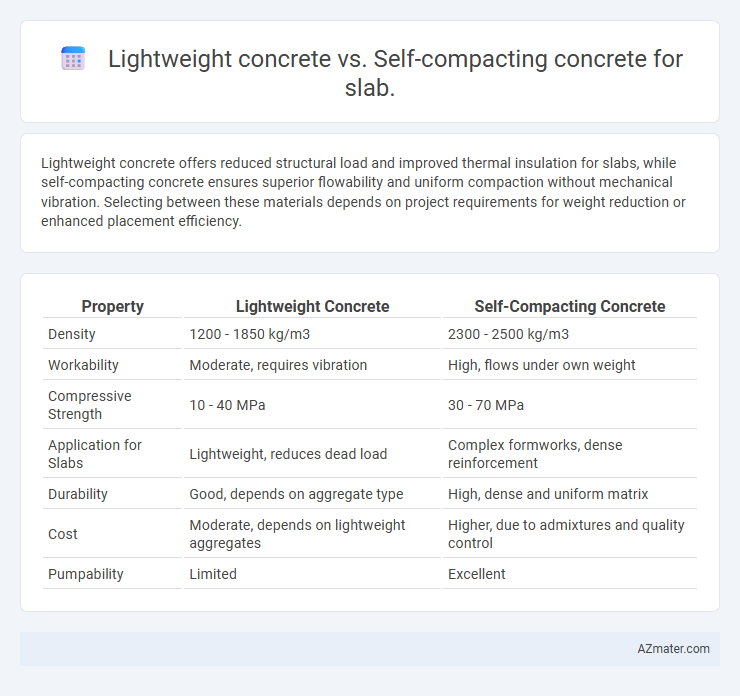Lightweight concrete offers reduced structural load and improved thermal insulation for slabs, while self-compacting concrete ensures superior flowability and uniform compaction without mechanical vibration. Selecting between these materials depends on project requirements for weight reduction or enhanced placement efficiency.
Table of Comparison
| Property | Lightweight Concrete | Self-Compacting Concrete |
|---|---|---|
| Density | 1200 - 1850 kg/m3 | 2300 - 2500 kg/m3 |
| Workability | Moderate, requires vibration | High, flows under own weight |
| Compressive Strength | 10 - 40 MPa | 30 - 70 MPa |
| Application for Slabs | Lightweight, reduces dead load | Complex formworks, dense reinforcement |
| Durability | Good, depends on aggregate type | High, dense and uniform matrix |
| Cost | Moderate, depends on lightweight aggregates | Higher, due to admixtures and quality control |
| Pumpability | Limited | Excellent |
Introduction to Lightweight Concrete and Self-Compacting Concrete
Lightweight concrete is characterized by its reduced density, achieved through the use of lightweight aggregates such as expanded clay, shale, or pumice, making it ideal for slabs requiring lower structural loads and improved thermal insulation. Self-compacting concrete is a highly flowable, non-segregating concrete that spreads into place and around reinforcement without the need for mechanical vibration, ensuring uniformity and superior surface finish in slab applications. Both materials enhance slab performance, with lightweight concrete prioritizing weight reduction and thermal properties, while self-compacting concrete emphasizes workability and surface quality.
Composition and Material Differences
Lightweight concrete for slabs incorporates lightweight aggregates such as expanded clay, shale, or pumice, reducing density and improving thermal insulation, while self-compacting concrete uses fine powders, superplasticizers, and carefully graded aggregates to achieve high flowability without segregation. The reduced coarse aggregate content in self-compacting concrete enhances its fluidity, whereas lightweight concrete maintains structural integrity through porous aggregates that lower dead load. Material differences affect workability and strength, with lightweight concrete emphasizing reduced weight and thermal properties, and self-compacting concrete prioritizing ease of placement and surface finish quality for slabs.
Workability and Placement Techniques
Lightweight concrete offers improved workability through reduced density, facilitating easier handling and placing on slabs without excessive compaction. Self-compacting concrete excels in workability by flowing smoothly into complex formworks and congested reinforcement areas without vibration. Placement techniques for lightweight concrete often involve manual or mechanical methods with moderate consolidation, while self-compacting concrete relies on gravity flow and its unique rheological properties to ensure uniform distribution and surface finish.
Weight and Structural Implications for Slabs
Lightweight concrete reduces slab weight by using lightweight aggregates, which decreases dead load and enhances seismic performance while maintaining adequate strength for structural applications. Self-compacting concrete offers improved workability and compaction without mechanical vibration, resulting in denser, more homogeneous slabs with superior durability and load distribution. Selecting lightweight concrete benefits weight-sensitive structures, while self-compacting concrete optimizes structural integrity and finish quality in slabs requiring complex reinforcement arrangements.
Strength and Durability Comparison
Lightweight concrete offers reduced structural load and improved thermal insulation but generally has lower compressive strength compared to self-compacting concrete (SCC), which provides high strength due to its dense microstructure and uniform compaction. SCC enhances durability through superior resistance to segregation, honeycombing, and enhanced bond strength with reinforcement, whereas lightweight concrete may suffer from increased porosity affecting long-term durability. For slab applications requiring exceptional strength and longevity, SCC is often preferred, while lightweight concrete is advantageous for weight-sensitive designs with moderate strength demands.
Surface Finish and Aesthetic Considerations
Lightweight concrete offers improved thermal insulation and reduced dead load for slabs but may present challenges in achieving smooth surface finishes due to its coarse aggregate variation. Self-compacting concrete (SCC) delivers superior surface quality with uniform texture and minimal surface defects, ideal for architectural slabs requiring high aesthetic standards. For projects prioritizing flawless finishes and intricate formwork details, SCC is preferred over lightweight concrete despite higher material costs.
Thermal and Acoustic Properties
Lightweight concrete offers superior thermal insulation due to its lower density and increased air voids, effectively reducing heat transfer in slab applications. Self-compacting concrete, while denser, provides enhanced acoustic performance through its homogeneous matrix, minimizing sound transmission and vibrations. Both materials improve slab performance in distinct ways, with lightweight concrete prioritizing thermal efficiency and self-compacting concrete optimizing acoustic comfort.
Cost Factors and Economic Viability
Lightweight concrete reduces structural load and foundation costs, offering economic advantages in slab construction through lower material density and improved thermal insulation. Self-compacting concrete, despite higher initial material costs due to specialized admixtures and increased cement content, reduces labor expenses and accelerates construction timelines by eliminating the need for vibration and formwork adjustments. Evaluating project scale and labor availability determines the cost-effectiveness, with lightweight concrete favoring large-span slabs and self-compacting concrete optimizing complex formworks and fast-track projects.
Application Suitability in Slab Construction
Lightweight concrete is ideal for slab construction where reduced structural load and improved thermal insulation are critical, commonly used in multi-story buildings and long-span slabs. Self-compacting concrete excels in intricate slab designs requiring high flowability and dense filling without vibration, ensuring uniformity and reducing labor costs. Selection depends on project demands, with lightweight concrete enhancing structural efficiency and self-compacting concrete optimizing complex formwork applications.
Summary and Recommendation
Lightweight concrete offers reduced structural load and enhanced thermal insulation, making it ideal for slabs in high-rise buildings or areas requiring weight reduction. Self-compacting concrete provides superior workability and excellent surface finish without the need for vibration, suitable for complex slab forms and congested reinforcement zones. For slabs demanding ease of placement and high durability, self-compacting concrete is recommended, while lightweight concrete is preferable when minimizing dead load and improving thermal performance are priorities.

Infographic: Lightweight concrete vs Self-compacting concrete for Slab
 azmater.com
azmater.com